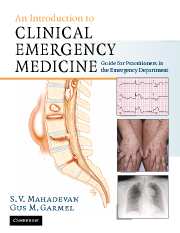Book contents
- Frontmatter
- Contents
- List of contributors
- Foreword
- Acknowledgments
- Dedication
- Section 1 Principles of Emergency Medicine
- Section 2 Primary Complaints
- 9 Abdominal pain
- 10 Abnormal behavior
- 11 Allergic reactions and anaphylactic syndromes
- 12 Altered mental status
- 13 Chest pain
- 14 Constipation
- 15 Crying and irritability
- 16 Diabetes-related emergencies
- 17 Diarrhea
- 18 Dizziness and vertigo
- 19 Ear pain, nosebleed and throat pain (ENT)
- 20 Extremity trauma
- 21 Eye pain, redness and visual loss
- 22 Fever in adults
- 23 Fever in children
- 24 Gastrointestinal bleeding
- 25 Headache
- 26 Hypertensive urgencies and emergencies
- 27 Joint pain
- 28 Low back pain
- 29 Pelvic pain
- 30 Rash
- 31 Scrotal pain
- 32 Seizures
- 33 Shortness of breath in adults
- 34 Shortness of breath in children
- 35 Syncope
- 36 Toxicologic emergencies
- 37 Urinary-related complaints
- 38 Vaginal bleeding
- 39 Vomiting
- 40 Weakness
- Section 3 Unique Issues in Emergency Medicine
- Section 4 Appendices
- Index
14 - Constipation
Published online by Cambridge University Press: 27 October 2009
- Frontmatter
- Contents
- List of contributors
- Foreword
- Acknowledgments
- Dedication
- Section 1 Principles of Emergency Medicine
- Section 2 Primary Complaints
- 9 Abdominal pain
- 10 Abnormal behavior
- 11 Allergic reactions and anaphylactic syndromes
- 12 Altered mental status
- 13 Chest pain
- 14 Constipation
- 15 Crying and irritability
- 16 Diabetes-related emergencies
- 17 Diarrhea
- 18 Dizziness and vertigo
- 19 Ear pain, nosebleed and throat pain (ENT)
- 20 Extremity trauma
- 21 Eye pain, redness and visual loss
- 22 Fever in adults
- 23 Fever in children
- 24 Gastrointestinal bleeding
- 25 Headache
- 26 Hypertensive urgencies and emergencies
- 27 Joint pain
- 28 Low back pain
- 29 Pelvic pain
- 30 Rash
- 31 Scrotal pain
- 32 Seizures
- 33 Shortness of breath in adults
- 34 Shortness of breath in children
- 35 Syncope
- 36 Toxicologic emergencies
- 37 Urinary-related complaints
- 38 Vaginal bleeding
- 39 Vomiting
- 40 Weakness
- Section 3 Unique Issues in Emergency Medicine
- Section 4 Appendices
- Index
Summary
Scope of the problem
Constipation may be defined as either stool frequency of less than three per week or, more generally, as difficulty in passing stool. In either case it should be recognized that constipation is a symptom, not a medical diagnosis.
It has been estimated that the prevalence of constipation in the adult population of industrialized nations is as high as 20%. There are approximately 2.5 million physician visits per year in the US for this symptom, and at least 20% of the population habitually use over-the-counter laxative preparations.
Constipation is a surprisingly frequent chief presenting complaint in the emergency department (ED) despite the medical community's attitude of it being a “minor” problem. It is particularly common in the elderly and those with multiple medical problems, complicating both their assessment and treatment for other conditions.
It is important to recognize constipation as a preventable adverse outcome of an ED visit, and to consider selecting discharge medications with this in mind.
Anatomic essentials
Normal bowel function has two components – colonic transit and defecation.
Colonic transit is maintained by smooth muscle function via bowel wall myenteric plexuses regulating motility and submucosal plexuses regulating absorption, with overall control by the parasympathetic nervous system. Transit time is also affected by bowel contents, specifically fiber and water.
Defecation is a complex series of events in which rectal distension triggers a series of reflexes to relax sphincters and pelvic floor muscles.
- Type
- Chapter
- Information
- An Introduction to Clinical Emergency MedicineGuide for Practitioners in the Emergency Department, pp. 211 - 216Publisher: Cambridge University PressPrint publication year: 2005

